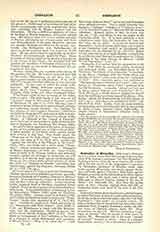

Gennings, EDMUND AND JOHN, the first, a martyr for the Catholic Faith, and the second, the restorer of the English province of Franciscan friars, were brothers and converts to the Church. Edmund Gennings was born at Lichfield in 1567; died in London, December 10, 1591. John was b. about 1570; d. at Douai, November 12, 1660.
Edmund, even in his boyhood, exhibited an unusual gravity of manners and a mystical turn of mind; when about sixteen years of age, he was converted to the Catholic Faith, and immediately afterwards entered the English College at Reims. He was ordained priest in 1590, being then only twenty-three years of age, and at once returned to England under the assumed name of Ironmonger. But his missionary career was of short duration, for he was seized whilst saying Mass in London on November 7, 1591, and executed at Gray’s Inn Fields on December 10 His martyrdom was the occasion of several remarkable incidents, chief of which was the conversion of his younger brother John. On his return to England, Edmund Gennings had at once gone to Lichfield to seek out his kindred in the hope of bringing them to the true faith, but he found that all his relatives were dead except this one brother, who had, however, left his native city and gone to London. Thither Edmund proceeded and for a whole month searched the city, visiting every place where he thought his brother might be found. Eventually, when he was about to give up the search, he achieved his purpose, but the younger brother, far from being won over to Edmund’s faith, only besought him to go away, lest he himself should become suspect; and when after awhile Edmund was seized and condemned John “rejoiced rather than bewailed the untimely and bloody end of his nearest kinsman, hoping thereby to be rid of all persuasions which he suspected he should receive from him touching the Catholic Religion“. So wrote John Gennings in his life of his brother, published in 1614 at St-Omer.
Undoubtedly at this time John Gennings was bent on pleasure, but one must make allowances for the spirit of remorse with which he looked back on those days in after years, and not accept his own estimate of his youth too readily. However, about ten days after his brother’s execution, a change came over him. He began one night to think of his brother’s death and contempt of the world, and to compare his own life with that of the martyr. He was struck with remorse and wept bitterly, and next prayed for light. Instantly he felt an exceeding great reverence for the saints and, above all, our Blessed Lady, and it seemed to him that he saw his brother in glory. He thereupon made a vow to forsake friends and country and seek a true knowledge of his brother’s faith. Being received into the Church, he entered Douai College, was ordained priest in 1607, and the following year was sent upon the English mission. Here he conceived a desire for the restoration of the English province of Franciscans, and sought out Father William Staney, the commissary of the English friars, and from him received the habit, either in 1610 or 1614 (the date is uncertain). After this, he went for a time to a convent of the order at Ypres, in Flanders, where he was joined by several English companions, amongst whom was Christopher Davenport, known in religion as Franciscus a Sancta Clara, afterwards a famous controversialist. Thus was the foundation of a new English province laid, and Father William Staney, recognizing the zeal of John Gennings, now gave into his hands the seal of the old province of the English Observants.
Gennings next proceeded to procure a house for the English friars at Gravelines, but in 1618 he obtained leave from the minister general to establish a settlement at Douai. As a matter of fact, most of the friars who had joined Gennings were alumni of Douai College, and in transferring their residence to that town he hoped to obtain a continuous supply of recruits. The work of restoring the English province was definitely confided to him by the general chapter of 1618, and he was nominated “Vicar of England“. To assist him in the work of restoration, the commissary general of the Belgian nation was empowered to gather together all the English and Scotch friars from any province in the order. A decree of the same general chapter placed the English Poor Clares of Gravelines under the jurisdiction of the English friars. In 1625, the number of English friars having greatly increased, Gennings sent Father Franciscus a Sancta Clara to Rome to plead that the English province be canonically established. The request was granted with the simple restriction that the superior of the province should not assume the title of provincial, but that of custos; but, in 1629, this restriction was taken away and Friar John Gennings was appointed minister provincial. The first chapter of the new province was held at Brussels in Advent of the same year, in the convent of the English sisters of the third order, which Gennings had himself founded in 1619. This community of tertiary sisters has continued to the present time, and is now established at Taunton, in England, with a branch house at Woodchester. Father John Gennings was reelected provincial in 1634, and again in 1643.
FATHER CUTHBERT

